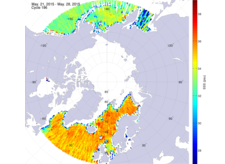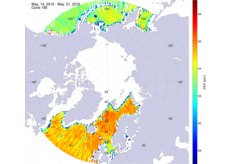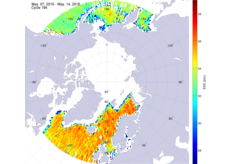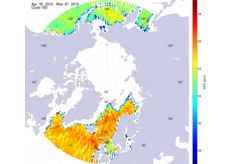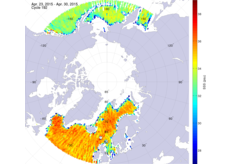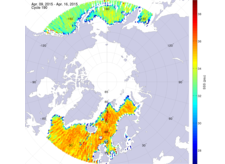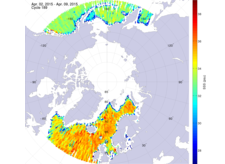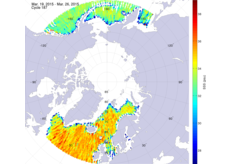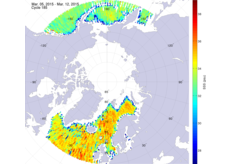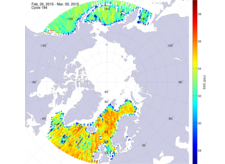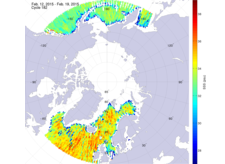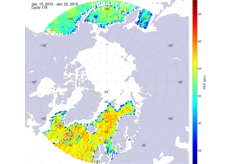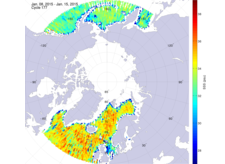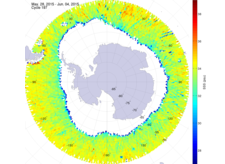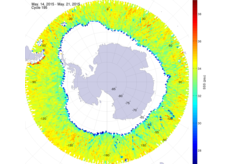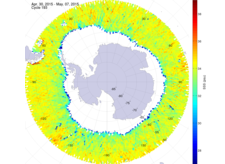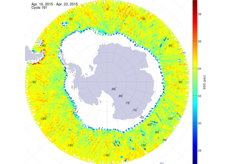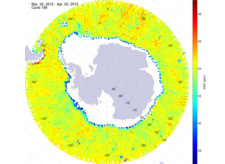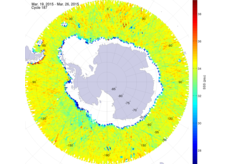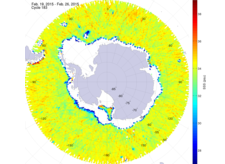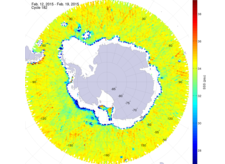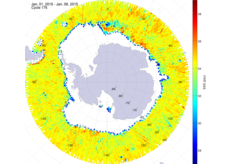Gallery: Sea Surface Salinity at High Latitudes
These weekly gridded maps are made using the Aquarius sea surface salinity retrievals. They were obtained with algorithms
developed by the Calibration/Validation working group, and applied to the microwave (L-band, about 1.4 GHz) brightness
temperature measurements along the spacecraft swath. These maps show sea surface salinity expressed in practical salinity unit
(psu) in the Northern and Southern Hemispheres at latitudes higher than 50°. Blue colors represent lower salinity, whereas
red colors represent higher salinity. The date shown on the images (below) is the first day of that weekly measurement.
Salinity can only be retrieved from space when the ocean is not covered by sea ice. Sea ice is frozen ocean water. It forms, grows, and melts according to the seasons, but some sea ice remains year round in certain regions of both the Arctic and Antarctic. When a significant fraction of sea ice is present in the Aquarius measurements, salinity cannot be retrieved accurately. These areas were masked on the maps. Other areas without data correspond to either a lack of observations due to orbit geometry and spacecraft maneuvers, or are coastal regions where salinity is inaccurate.
The data presented are a weekly gridded average of the swath data distributed by NASA's Physical Oceanography Distributed Active Archive Center (PO.DAAC) and provided by Ludovic Brucker (1,2) and Emmanuel Dinnat (1,3). Aquarius Level-3 weekly polar-gridded data sets can be downloaded from the National Snow and Ice Data Center (NSIDC).
These maps also show the significant difference between the saltier Atlantic Ocean and the fresher Pacific Ocean. Ocean surface salinity in polar regions varies seasonally as ice freezes (i.e., leaving saltier water in the ocean) and melts (i.e., adding fresh water to the ocean).
Brucker, L., Dinnat, E.P., and Koenig, L.S. (2014b). Weekly Gridded Aquarius L-band Radiometer/Scatterometer Observations and Salinity Retrievals Over the Polar Regions - Part 2: Initial Product Analysis, The Cryosphere, 8, 915-930, doi:10.5194/tc-8-915-2014.
Brucker, L., Dinnat, E.P., Picard, G., and Champollion, N. (2014c). Effect of Snow Surface Metamorphism on Aquarius L-Band Radiometer Observations at Dome C, Antarctica, IEEE Transactions on Geoscience and Remote Sensing, 52 (11), 1-10, doi: 10.1109/TGRS.2014.2312102.
Salinity can only be retrieved from space when the ocean is not covered by sea ice. Sea ice is frozen ocean water. It forms, grows, and melts according to the seasons, but some sea ice remains year round in certain regions of both the Arctic and Antarctic. When a significant fraction of sea ice is present in the Aquarius measurements, salinity cannot be retrieved accurately. These areas were masked on the maps. Other areas without data correspond to either a lack of observations due to orbit geometry and spacecraft maneuvers, or are coastal regions where salinity is inaccurate.
The data presented are a weekly gridded average of the swath data distributed by NASA's Physical Oceanography Distributed Active Archive Center (PO.DAAC) and provided by Ludovic Brucker (1,2) and Emmanuel Dinnat (1,3). Aquarius Level-3 weekly polar-gridded data sets can be downloaded from the National Snow and Ice Data Center (NSIDC).
(1) NASA Goddard Space Flight Center, Cryospheric Sciences Lab, Greenbelt MD, USA
(2) Universities Space Research Association, Greenbelt MD, USA
(3) Chapman University, Orange CA, USA
(2) Universities Space Research Association, Greenbelt MD, USA
(3) Chapman University, Orange CA, USA
Aquarius Retrieved Sea Surface Salinity in the Northern High-Latitude Ocean
When ocean surface salinity retrievals are possible in the Arctic Ocean, values are smaller than for other regions. One can
also see that blue colors are usually present in the vicinity of the sea ice margin. This may result from sea ice contamination
of the Aquarius measurements, and do not necessarily reflect a low salinity.These maps also show the significant difference between the saltier Atlantic Ocean and the fresher Pacific Ocean. Ocean surface salinity in polar regions varies seasonally as ice freezes (i.e., leaving saltier water in the ocean) and melts (i.e., adding fresh water to the ocean).
2015 Maps: Northern Hemisphere | |||||||||
May 28, 2015 | May 21, 2015 | May 14, 2015 | May 7, 2015 | ||||||
April 30, 2015 | April 23, 2015 | April 16, 2015 | April 9, 2015 | ||||||
April 2, 2015 | March 26, 2015 | March 19, 2015 | March 12, 2015 | ||||||
March 5, 2015 | February 26, 2015 | February 19, 2015 | February 12, 2015 | ||||||
February 5, 2015 | January 29, 2015 | January 22, 2015 | January 15, 2015 | ||||||
January 8, 2015 | January 1, 2015 | ||||||||
Aquarius Retrieved Sea Surface Salinity in the Southern High-Latitude Ocean
The Southern Ocean is an important source for deep water formations, and therefore the thermohaline circulation. Downwelling
of upper layer water is induced by surface cooling and salt rejection during the formation and growth of sea ice. However, sea
surface salinity retrieval in the Southern Ocean is challenging. There are strong winds, and the circulation in the Southern
Ocean is dominated by the Antarctic Circumpolar Current, which is regarded as the largest World's ocean current. Salinity
retrieval is less accurate for very rough sea surfaces. In addition, waters around Antarctica are cold. Aquarius measurements
are less sensitive to salinity in cold waters. Finally, the presence of sea ice add an additional complexity to the monitoring
of salinity in the high latitudes of the Southern Hemisphere.2015 Maps: Southern Hemisphere | ||||||
May 28, 2015 | May 21, 2015 | May 14, 2015 | May 7, 2015 | |||
April 30, 2015 | April 23, 2015 | April 16, 2015 | April 9, 2015 | |||
April 2, 2015 | March 26, 2015 | March 19, 2015 | March 12, 2015 | |||
March 5, 2015 | February 26, 2015 | February 19, 2015 | February 12, 2015 | |||
February 5, 2015 | January 29, 2015 | January 22, 2015 | January 15, 2015 | |||
January 8, 2015 | January 1, 2015 | |||||
Publications
Brucker, L., Dinnat, E.P., and Koenig, L.S. (2014a). Weekly Gridded Aquarius L-band Radiometer/Scatterometer Observations and Salinity Retrievals Over the Polar Regions - Part 1: Product Description, The Cryosphere, 8, 905-913, doi:10.5194/tc-8-905-2014. Brucker, L., Dinnat, E.P., and Koenig, L.S. (2014b). Weekly Gridded Aquarius L-band Radiometer/Scatterometer Observations and Salinity Retrievals Over the Polar Regions - Part 2: Initial Product Analysis, The Cryosphere, 8, 915-930, doi:10.5194/tc-8-915-2014.
Brucker, L., Dinnat, E.P., Picard, G., and Champollion, N. (2014c). Effect of Snow Surface Metamorphism on Aquarius L-Band Radiometer Observations at Dome C, Antarctica, IEEE Transactions on Geoscience and Remote Sensing, 52 (11), 1-10, doi: 10.1109/TGRS.2014.2312102.


